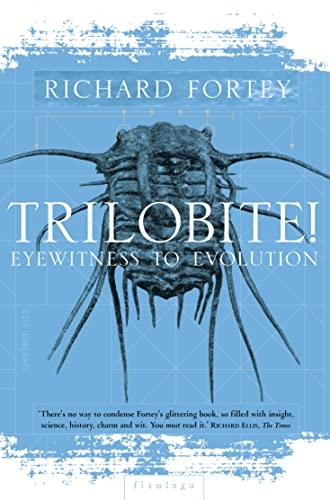Sep. 17th, 2016
Book 75 - Richard A. Fortey "Trilobite"
Sep. 17th, 2016 11:29 amRichard A. Fortey "Trilobite: Eyewitness to Evolution" (Flamingo)

I started this with no idea how interesting I'd find it as geological or palaeontological subjects are not my normal cup of tea.
Trilobites were a group of arthropods which lived during the pre-Cambrian to Permian time periods from approximately 540-250 ma (million years ago). They ranged in size from a less than a millimeter to that of a dinner plate. They were salt-water creatures, some deep water crawlers and blind, some free-swimming, some along shallow shorelines. Their eyes (of those who had them) were made of calcite. Fossils abound worldwide, and that's what makes them particularly interesting even to the layperson: because of how long this class of animals survived, and their easily-fossilised exoskeleton, they have been of crucial help in plotting the movements of continental masses through several comings together and breakups, including Pangaea, about 300 ma, and the previous super continent, Pannotia (about 600 ma). For instance, did you know that England and Wales used to be part of a land mass which included eastern (but not western) Newfoundland? The land grouping is now referred to as Avalonia (who said scientists have no sense of humor?) Western Newfoundland was an ocean away. During the Ordovician (say 485 ma), the Laurentian continent, including North America and Greenland, lay along the equator - at a 90-degree angle to today's position. Northern Africa was at the South Pole.
The author, a British palaeontologist, uses biography, natural history, geology, and even a bit of travelogue to reel in the reader. I was enchanted.

I started this with no idea how interesting I'd find it as geological or palaeontological subjects are not my normal cup of tea.
Trilobites were a group of arthropods which lived during the pre-Cambrian to Permian time periods from approximately 540-250 ma (million years ago). They ranged in size from a less than a millimeter to that of a dinner plate. They were salt-water creatures, some deep water crawlers and blind, some free-swimming, some along shallow shorelines. Their eyes (of those who had them) were made of calcite. Fossils abound worldwide, and that's what makes them particularly interesting even to the layperson: because of how long this class of animals survived, and their easily-fossilised exoskeleton, they have been of crucial help in plotting the movements of continental masses through several comings together and breakups, including Pangaea, about 300 ma, and the previous super continent, Pannotia (about 600 ma). For instance, did you know that England and Wales used to be part of a land mass which included eastern (but not western) Newfoundland? The land grouping is now referred to as Avalonia (who said scientists have no sense of humor?) Western Newfoundland was an ocean away. During the Ordovician (say 485 ma), the Laurentian continent, including North America and Greenland, lay along the equator - at a 90-degree angle to today's position. Northern Africa was at the South Pole.
The author, a British palaeontologist, uses biography, natural history, geology, and even a bit of travelogue to reel in the reader. I was enchanted.
These are the few limits on our ability to know.
http://nautil.us/issue/40/learning/how-much-more-can-we-learn-about-the-universe

COLLIDING GALAXIES: Such cosmic commotion will one day cease to occur, and observers in the distant future may never realize how dynamic our universe once was.
http://nautil.us/issue/40/learning/how-much-more-can-we-learn-about-the-universe

COLLIDING GALAXIES: Such cosmic commotion will one day cease to occur, and observers in the distant future may never realize how dynamic our universe once was.
In unseen worlds, science invariably crosses paths with fantasy.
http://nautil.us/issue/11/Light/why-physicists-make-up-stories-in-the-dark

http://nautil.us/issue/11/Light/why-physicists-make-up-stories-in-the-dark

As it is now the weekend some soulful grooves are the order of the day -
Laura Mvula - She
Taken from the Mercury Prize ‘Albums of the Year’ nominated ‘Sing To The Moon’ - awesome voice! Laura hails from the city of Birmingham. Mvula grew up in the Birmingham suburbs of Selly Park and Kings Heath with two younger siblings and was influenced by the girl band Eternal. Her mother is from Saint Kitts and her father is from Jamaica.
( More grooves here )
Laura Mvula - She
Taken from the Mercury Prize ‘Albums of the Year’ nominated ‘Sing To The Moon’ - awesome voice! Laura hails from the city of Birmingham. Mvula grew up in the Birmingham suburbs of Selly Park and Kings Heath with two younger siblings and was influenced by the girl band Eternal. Her mother is from Saint Kitts and her father is from Jamaica.
( More grooves here )




